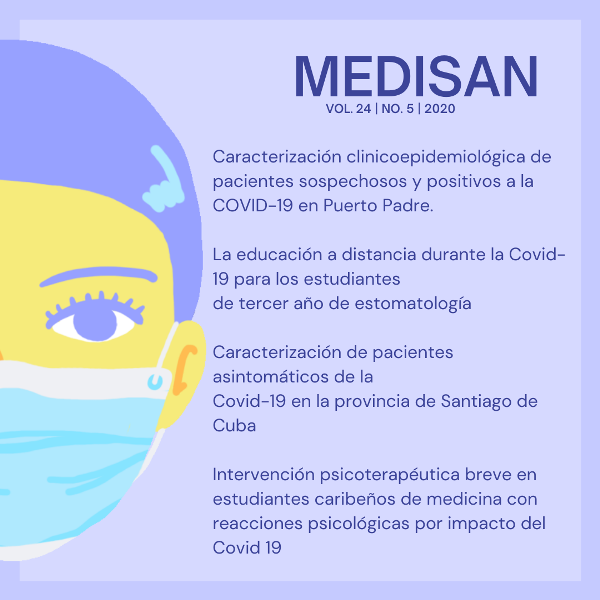Digital models 3D in the teaching-learning process of the medical sciences
Keywords:
teaching-learning process, digital models 3D, Medical Sciences careers, didactic means.Abstract
Medical Sciences universities should adapt to the changes imposed by the technological advances at the present time. Digital models 3D facilitate the delivering of contents related to anatomical, morphological objects and medical phenomena that occasionally, can be complicated and/or abstract for the students. With this work it is intended to analyze the advantages associated with the use of such models in the teaching - learning process of the Medical Sciences careers, since an insufficient technological culture exists in professors of these careers taking into account the wide possibilities that digital models 3D can offer to support the specific contents of subjects, which limits the development of the teaching-learning process. Such models can be incorporate as important didactic means of last generation, which tend to achieve better motivation and understanding levels of the contents on the students.
Downloads
References
2. Castro SM, Delrieux C, Silvetti A. Computación Gráfica en la Universidad Nacional del Sur. La Plata: Universidad Nacional de la Plata; 2001 [citado 08/12/2019]. Disponible en: http://sedici.unlp.edu.ar/handle/10915/23559
3. Mesa Múnera E, Ramírez Salazar JF, Branch Bedoya JW. Construcción de un modelo digital 3D de piezas precolombinas utilizando escaneo láser. Ava Sis Inf. 2010 [citado 08/12/2019]; 7 (1). Disponible en: https://revistas.unal.edu.co/index.php/avances/article/view/20611/21637
4. Saorin JL, de la Torre Cantero J, Melian D, Meier C, Rivero Trujillo D. Blokify: Juego de modelado e impresión 3D en tableta digital para el aprendizaje de vistas normalizadas y perspectiva. Digital Education Review. 2015 [citado 15/01/2020]; (27). Disponible en: http://revistes.ub.edu/index.php/der/article/view/11651
5. De Antonio Jiménez A, Villalobos Abarca M, Luna Ramírez E. Cuándo y cómo usar la realidad virtual en la enseñanza. Revista Iberoamericana de Informática Educativa. 2000 [citado 15/01/2020]; (16). Disponible en: https://dialnet.unirioja.es/servlet/articulo?codigo=4794517
6. Ávila Forero JS. Diseño de material didáctico para la enseñanza de anatomía. Editorial Universitat Politècnica de València. 2016 [citado 15/01/2020]. Disponible en: http://ocs.editorial.upv.es/index.php/IFDP/IFDP/paper/viewFile/2955/2154
7. Francesc Marc EM, Adell Segura J, Gisbert Cervera M. Diseño de un entorno 3D para el desarrollo de la competencia digital docente en estudiantes universitarios: usabilidad, adecuación y percepción de utilidad. 2014. RELATEC. 2014 [citado 15/01/2020]; 13 (2) (2014): 3547. Disponible en: https://relatec.unex.es/article/view/1443
8. Vizconde Veraszto E, Franco de Camargo JT, Barros Filho J, García García F. Estrategias para el desarrollo de contenido educativo 3d. Producción de animaciones modeladas por ordenador utilizando software libre. Icono 14. 2012 [citado 15/01/2020]; 10 (1). Disponible en: https://icono14.net/ojs/index.php/icono14/article/view/26
9. Esteve Mon FM. La competencia digital docente. Análisis de la autopercepción y evaluación del desempeño de los estudiantes universitarios de educación por medio de un entorno 3D. Tesis doctoral. Tarragona: Universitat Rovira i Virgili; 2015 [citado 15/01/2020]. Disponible en: https://www.researchgate.net/publication/274896917_La_competencia_digital_docente_analisis_de_la_autopercepcion_y_evaluacion_del_desempeno_de_los_estudiantes_universitarios_de_educacion_por_medio_de_un_entorno_3D
10. García Ramírez GN. Estudio de tecnología de modelado 3D para su aplicación en escultura sustentable. (Tesis de Doctorado). Toluca: Universidad Autónoma del Estado de México; 2017 [citado 15/01/2020] . Disponible en: http://ri.uaemex.mx/bitstream/handle/20.500.11799/66445/Estudio%20de%20tecnolog%c3%ada%20de%20modelado%203D%20para%20su%20aplicaci%c3%b3n%20en%20escultura%20sustentable-split-merge.pdf?sequence=5&isAllowed=y
11. De la Torre Cantero J, Martin Dorta N, Saorín Pérez JL, Carbonell Carrera C, Contero González M. Entorno de aprendizaje ubicuo con realidad aumentada y tabletas para estimular la comprensión del espacio tridimensional. RED. 2013 [citado 15/01/2020]; (37). Disponible en: https://revistas.um.es/red/article/view/234041/179811
Published
How to Cite
Issue
Section
License
All the articles can be downloaded or read for free. The journal does not charge any amount of money to the authors for the reception, edition or the publication of the articles, making the whole process completely free. Medisan has no embargo period and it is published under the license of Creative Commons, International Non Commercial Recognition 4.0, which authorizes the copy, reproduction and the total or partial distribution of the articles in any format or platform, with the conditions of citing the source of information and not to be used for profitable purposes.





